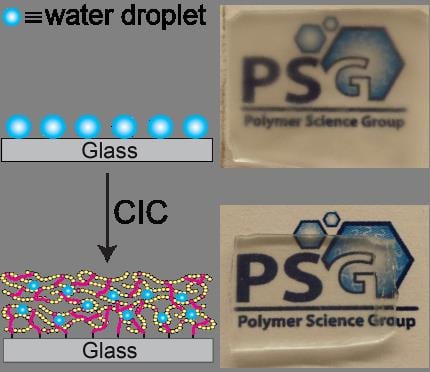Those of us wearing glasses are all too painfully aware of the effect of fogging. You finally get out of the cold and into a nicely heated environment only to have your vision taken from you by a white wall in front of your eyes. The phenomenon of fogging primarily occurs as the result of a change in environmental conditions such as temperature and/or humidity, whereby water vapor in the air condenses onto a surface, generating large discrete water droplets that give rise to light scattering. This phenomenon does of course not only occur on glasses, mirrors, and windows, but also on delicate analytical and medical devices or optical sensor arrays.
Fogging can be fought in two very different ways. The energy of a surface can be increased by making it more hydrophilic, leading to a fast spreading of the water droplets and thereby reducing light scattering. The second option is turning the surface superhydrophobic and thereby water-repellent.
 In their recent work, G. G. Qiao and coworkers used the first approach to generate nanoscale antifogging surfaces. They report the facile synthesis of cross-linked, surface-confined antifogging coatings with high tuneability via catalyst-induced cross-linking (CIC) using ring-opening metathesis polymerization (ROMP). This technique occurs under mild reaction conditions (at room temperature and in the presence of air) and does not require the use of heat or UV light to induce cross-linking. To test their antifogging ability, substrates were exposed to abrupt temperature changes (-20 °C to 22 °C).
In their recent work, G. G. Qiao and coworkers used the first approach to generate nanoscale antifogging surfaces. They report the facile synthesis of cross-linked, surface-confined antifogging coatings with high tuneability via catalyst-induced cross-linking (CIC) using ring-opening metathesis polymerization (ROMP). This technique occurs under mild reaction conditions (at room temperature and in the presence of air) and does not require the use of heat or UV light to induce cross-linking. To test their antifogging ability, substrates were exposed to abrupt temperature changes (-20 °C to 22 °C).
Their approach allowed them to vary the hydrophilicity as well as the crosslinking density of their films. Several polymers with different hydrophilicities were used to assess antifogging performance. The most hydrophilic polymer films displayed the best antifogging function, as evident from high UV-vis transmittance measurements and visual observation. Furthermore, films prepared from the same polymer (constant hydrophilicity) but with different cross-linking densities were used to independently investigate the effect of film cross-linking on antifogging performance. The most densely cross-linked films resulted in the shortest antifogging performance, while the loosely cross-linked films remained fog free. These results indicate that a balance of hydrophilicity and cross-linking density (swellability) plays a crucial role in antifogging performance. Antifogging films need to have enough water vapor absorption and swelling, whilst still being cross-linked enough to maintain film stability. These insights will be valuable in the development of new antifogging surfaces for a fog-free future.

















